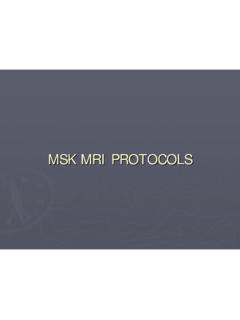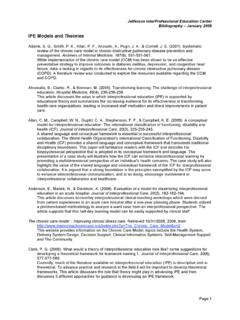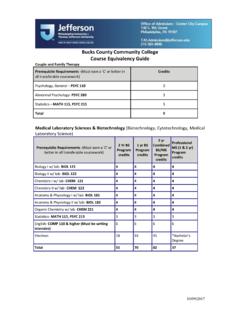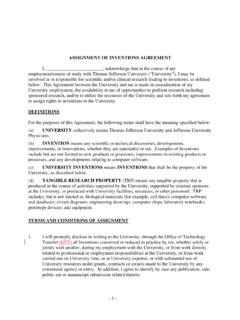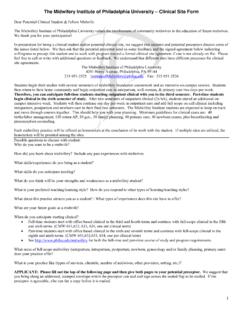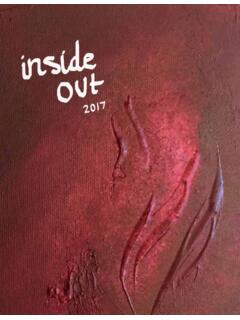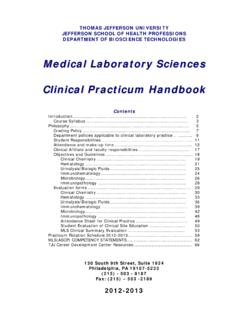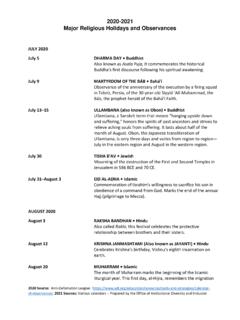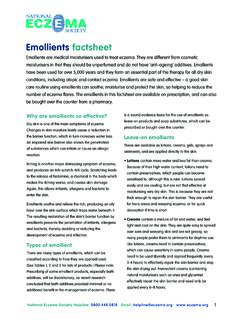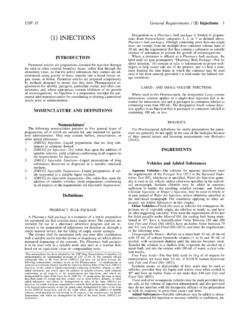Transcription of Step by Step instruction for frozen sample preparation for ...
1 TJU SKCC Path-Core 1 | P a g e Step by Step instruction for frozen sample preparation for histology assay in non-histopathology lab environment Note: Before planning a frozen section project, please note that: frozen tissue work always needs an appointment in advance. Before you bring your samples to the core facility, please contact us to make an appointment first. Both fixed and un-fixed tissue samples can be frozen sectioned.
2 If tissue is not being preserved by a fixative, it is imperative that the tissue should be frozen as quickly as possible after the tissue is devascularized. The submitted samples can be accepted either as fresh tissue on ice, formaldehyde fixed tissues in 30% sucrose, snap- frozen tissues, or OCT embedded frozen blocks. If the sample has been fixed with formaldehyde containing fixatives, it must be cryoprotected with 30% sucrose in 1 PBS (See procedure bellow: 3. Fixation). Submit the tissue in 30% sucrose in 1 PBS or frozen embed your tissue samples in OCT compound and submit the tissue to the core facility as your earliest convenience.
3 On the day of your frozen section appointment, put the samples on dry-ice or in liquid nitrogen and bring it to our Core Facility. Never freeze and thaw the frozen tissue, or ice crystal artefact will occur. Any leftover frozen tissues can be paraffin embedded through a special processing procedure. This instruction is specifically designed for those who work in non-histopathology lab environment to prepare frozen sample for histology assay. Please always be aware that it is important to keep fresh tissues on ice and process them within 5-10 minutes of devascularization to well preserve the nuclear acid and protein in the fresh tissue samples.
4 1. Grossing: Samples should be grossed the same way as described in the instruction for sample preparation for paraffin processing . Avoid crushing artefacts by gently but firmly securing the specimen while cutting. 2. Size of the sample : Smaller size is preferred as it can be frozen faster than a larger one. But while you prepare fresh sample for frozen section, the thickness is not as critical as paraffin processing sample , it could be 1 cm or a little bit more. 3. Fixation (optional): The sample can be fixed before or after the grossing. Again, if the sample has been fixed with formaldehyde fixatives, it should be rinsed with 1 PBS for 10 minutes, 3 times, transferred into 15% sucrose in 1 PBS at 4 C until tissue sinks, then transferred into 30% sucrose in 1 PBS at 4 C until tissue sinks.
5 You might need to perform antigen retrieval procedure to expose the TJU SKCC Path-Core 2 | P a g e epitopes due to the cross-link effect of aldehyde fixatives when perform immunostaining on these samples. 4. Rinse and dry: Remove excess liquid surround the tissue by absorption with Kim-wipe, gauze or paper towel prior to freezing. Otherwise, these liquid will form ice crystal on the surface of tissue and prevent tissue attach to frozen embedding media ( OCT compound) when the tissue is frozen embedded and cause a lot of difficulties during sectioning.
6 This procedure only takes a few more seconds, but it will make a dramatic difference for the sectioning process later on. 5. Snap- frozen (optional): Samples could be snap- frozen on dry-ice or in liquid nitrogen when: They are collected over a period of time and cannot be processed simultaneously. There are too many samples to process at once. Samples are collected in the field, or the mechanical processing of fresh samples is insufficient for thorough disruption. While freezing allows the researcher to postpone DNA/RNA/protein isolation, it is time consuming and makes subsequent RNA isolation a more laborious process.
7 Ideally, specimens should be snap- frozen or placed in appropriate reagent within 5 minutes from loss of vascularization to prevent the DNA, RNA and protein from degradation and keep the best morphology. Transfer the frozen sample into a cold, labeled cryo-vial, with a screw-top lid. It is not recommended to put the fresh tissue inside the cryo-vial first and snap-freezing the tissue in the vial. It will become very difficult to take the tissue out of the tube later. Powder Dry-ice/Cold isopentane in Granular Dry-ice / liquid nitrogen + cryo-vial method provides excellent specimen integrity and a wide array of options for tissue analysis (See Cold source below).
8 The vials can be stored in a liquid nitrogen storage tank or -80 C freezer for long-term storage. 6. Cold Source: An ideal cold source should be able to freeze down the tissue relative quickly and evenly. Because the faster you freeze down the samples, the less chance of ice crystal artefact will occur. But on the other hand, freezing tissue too quickly, such as submersing the tissue directly into the liquid nitrogen will cause the tissues or blocks crack, which will make them very difficult or impossible to section. This happens because the outside tissue begins to freeze much more quickly than internal portion.
9 The following cold sources are recommended for those who want to embed their samples by themselves in a research laboratory without special frozen apparatus: TJU SKCC Path-Core 3 | P a g e 1) One simple method is to use dry ice ( C) in block form placed in a Styrofoam container. Place the filled cryomold on the block to freeze it. This method has the advantages of simplicity and safety, but does not freeze the tissue as rapidly as immersion in a freezing medium.
10 Note: Freezing tissue on granular/pellet dry-ice or in the freezer is not recommended. These cold sources neither provide an even freezing nor freeze the tissue quickly enough. This will cause freezing artefacts, and desiccation of the tissue. 2) The 2nd method we recommend is to use dry ice in pellet form. Place a small stainless steel bowl (or Pyrex or polypropylene beaker) in the bottom of a Styrofoam container and fill the space around the bowl with dry ice pellets. Place some pellets in the bowl and slowly add isopentane/2-methylbutane. Work in a fume hood, of course, as these are flammable.
